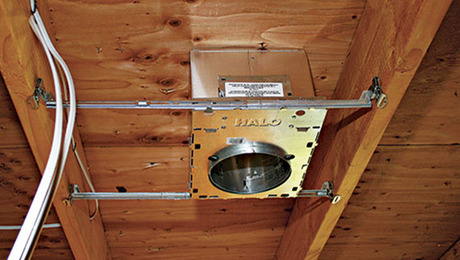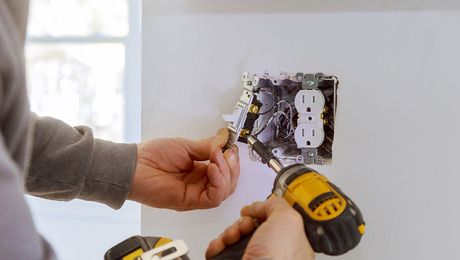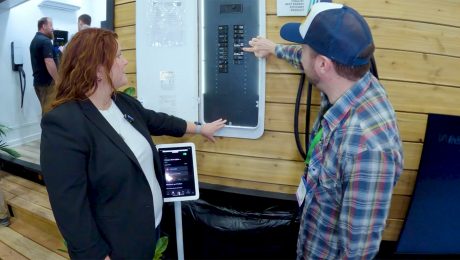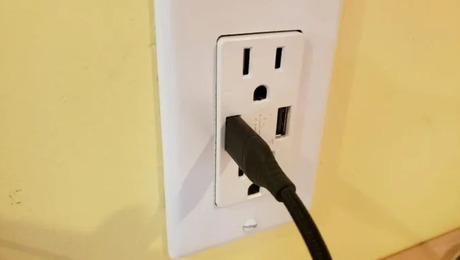Plugging into the Sun
Solar electricity was always a good idea. Is it finally affordable?
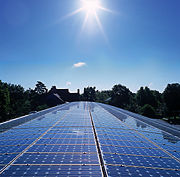
Twenty years ago, when Ronald Reagan tore Jimmy Carter’s solar water heater from the White House roof and then took away tax credits for renewable energy, the solar-energy industry plummeted faster than dot-coms in the new millennium. Thousands of small solar businesses disappeared overnight, and only a few survived. In recent years, these surviving few have been joined by a new generation of solar-energy advocates who have the backing of state and federal energy departments and international companies like BP, Shell and Sharp, and are finding improved ways to put the sun to work.
One of the most promising forms of solar technology is photovoltaics, or PV for short, which converts sunlight into electricity without the problems associated with fossil fuels (see How a photovoltaic system works). The technology is not new; the first practical applications powered satellites in the space program in the 1960s. Since then, PV has powered everything from calculators and road signs to irrigation and telecommunications systems. Allen Barnett, CEO of solar-cell producer Astropower Inc., says that the PV industry is growing 25% to 30% a year.
How a photovoltaic system works
Solar cells are arranged in modules or panels, which are wired in series into arrays. These arrays deliver direct current to an inverter that converts it to alternating household current. The potential maximum output of the system (peak) is measured in thousands of watts per hour per day (kwh/day).
Inverters convert direct current into alternating household current; more sophisticated models manage the grid connections, net-metering and safety disconnects as well. A newer technology currently available in Europe and Australia incorporates individual inverters into each solar panel, creating a stand-alone module that can be linked easily to other similar panels.
Batteries are an integral part of an off-grid system and also can be used for backup in grid-connected systems. Deep-cycle batteries are priced according to the number of times they can be charged and discharged. More expensive industrial-quality batteries are prewired and will last 15 to 20 years. They can be discharged to 80% without being damaged, so homeowners have more stored electricity at their disposal. Smaller arrays of four to eight batteries may be used with grid-connected systems to maintain electricity to essential circuits during power outages. Because they contain dangerous chemicals and emit hydrogen gas, all batteries must have their own separate vented space. Batteries also require regular monitoring of charge levels and maintenance to avoid energy losses.
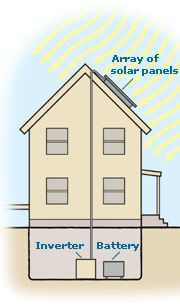
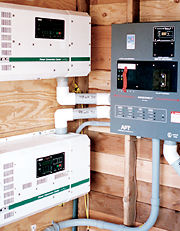
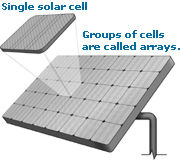
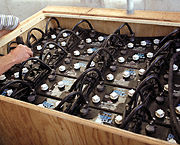
In the past, residential applications for PV have been largely limited to powering off-the-grid homes and rural vacation cabins. That’s because installing a PV system often costs much less than running utility lines, making remote, inexpensive land buildable. But now PV is making inroads in suburbia as well. National and regional homebuilders such as US Homes, Shea and Pardee are beginning to offer solar electric systems on the houses they sell. The Home Depot also has joined in with pilot programs in California, New Jersey, Delaware and Long Island, New York, through which it finances, sells and installs systems on existing homes.
Two big reasons for this growth are the electric-utility deregulation of the late 1990s and recently enacted state-government incentives. Deregulation has enabled homeowners in most states to connect their PV systems to the power grid and sell their excess production to a utility. This sale is reflected as a credit on their electric bills, a process called net-metering. In addition, many states offer tax incentives and/or rebates to homeowners who install PV systems (see Making photovoltaics cost-effective).
So why doesn’t everyone have solar panels sprouting from their roofs? Because the sun doesn’t shine equally in all areas of the country; because the technology isn’t widely recognized yet; because financial support from state and federal governments is uneven; and because it’s expensive — in effect, a PV system can be like buying 20 years of electricity in one fell swoop. Still, many of the major international oil and electronics companies are convinced that PV is a big potential market, and they’re investing considerable resources toward its development. So are major industrial countries such as Germany and Japan. For anyone who wants to live off-grid or who just likes the idea of making cleaner energy, photovoltaics are becoming a truly viable alternative.
Making PV cost-effective
Conservative estimates put the cost of PV-generated power at between 20¢ and 40¢ per kwh over the life of the system. However, other factors such as net-metering, state-funded rebates and tax credits can reduce the overall cost in some locations by as much as half.
Net-metering allows a PV system to feed its surplus power into the utility’s grid; the homeowner receives a credit (usually equal to the utility rate) and pays only for the net amount used. Most (but not all) states allow net-metering.
Typically, rebates are given based on the amount of electricity systems can produce. California offers a rebate of $4 per watt, under its Emerging Renewables Program. Many other states offer similar incentives that can halve PV costs. To qualify, homeowners often must employ licensed installers. Other types of incentives include utility rebates, low-rate loans and grants. To learn the particulars of each state’s incentives, visit www.dsireusa.org.
Estimating the lifetime cost of a PV system
Depending on locally available subsidies, a PV system can add tens of thousands of dollars to the cost of your house or put money in your pocket. Below is a way to get an idea of the rough lifetime cost of a PV system, using an average house as an example. To make it specific to your situation, plug in your daily hours of sunlight from the map below, your power usage and the cost per kwh in your area.
Doing the math
- To size the system, divide daily power consumption by the average hours of full sun per day. Our sample house uses 30kwh per day, gets 4.5 hours of sun and would need a 6.67kw system (30kwh ÷ 4.5 hours = 6.67kw).
- At a national average cost of $6,000 per kw, this system would cost about $40,000.
- Over the course of 20 years (a conservative estimate of the life of a PV system), this house’s system would generate 219,000kwh of power. At 8¢ per kwh, that’s $17,520 worth of electricity.
Cashing in?
After factoring in the value of the electricity generated, this PV system’s net cost is $22,480. But wait: If this house were in Orlando’s above-average sun and took advantage of a state subsidy of $3,000 per kw, the net gain to the owner over 20 years would have been $1,152. With California’s $4,000 per kw subsidy, this system in Fresno would put $12,617 in the owner’s pocket. The situation in Illinois is similar to California. (Totals do not reflect future increases in utility costs or interest rates.)
An online calculator can help you to figure system costs for a variety of scenarios. Data based on information courtesy of U. S. Department of Energy Office of Energy Efficiency and Renewable Energy (www.eere.energy.gov/state_energy).
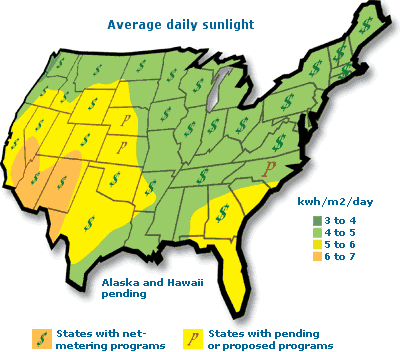
There are three types of PV silicon cells
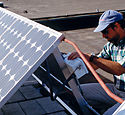
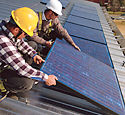
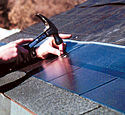
Pre-engineered systems take out some of the guesswork
Recently, manufacturers have begun marketing pre-engineered systems to make hardware selection easier. With a pre-engineered system, you choose the system size you want, typically between eight and 32 100w or 120w modules, and whether you want battery backup. The packager then adds the appropriate mounting hardware and inverter. Buying components as a kit or package can save money (5% or more), plus many companies offer technical support.
Choosing a solar contractor
Much of the labor for installing a PV system can be done by tradesmen or even by skilled homeowners. Roofing and wiring skills are, of course, prerequisites. But manufacturers have worked to make installing systems easier. Wiring the relatively lightweight (30-pound) panels together and to roof-top junction boxes, for example, is “plug and play.” New module mounting systems have specially extruded rails that make module alignment easy by accepting sliding mounting feet and module clamps. Flashing details for mounting posts have also been improved and are now similar to flashing for vent stacks.
That said, there’s no substitute for experience. Arno Harris, a San Diego solar contractor and president of Prevalent Power, Inc., encourages both homeowners and contractors to hire professional solar power specialists to do the job. “There are a number of complex variables involved in sizing a system, including how much power to replace based on analysis of power bills and billing rates, how much power the system will really put out, and electrical dynamics that occur under load. It’s analogous in scope to sizing an HVAC system…not rocket science, but it would be hard to pick it up in just a day or so.”
Chris Warfel, a solar engineer in Rhode Island, says if you’re going to oversee most of the installation yourself, be prepared to run into some blank stares if you call your electrician for help. He says: “There are people who know solar and people who know electrical systems, but there aren’t many who know a lot about both.”
Everett Barber, a solar installer for 27 years with Sunsearch, Inc. in Guilford, Connecticut, agrees. Barber feels that it’s wise to consult with a licensed solar installer before you begin installing expensive components, especially when homeowners want a custom system that can do things beyond what the pre-engineered systems offer, such as powering DC appliances directly, solving orientation problems and providing for longer emergency back-up capability. Companies such as his conduct feasibility studies and will design and install the systems as well. In addition, solar professionals are knowledgeable about state rebates, grants, loans and tax incentives and can help homeowners with the application processes.
Figuring out your payback
The length of time it will take to recoup the cost of a PV system depends on a number of variables, including available sunlight; system size, cost and efficiency (see Will photovoltaics work on your house?); current and future electric rates; and the financial incentives that are available in your state.
Some homeowners finance their system with a home-equity loan, enabling them to have the benefits of PV with little or no out-of-pocket cost. This gives a different way to look at payback. For example, the yearly interest payment on a $40,000 home-equity loan with a 5% rate is $2,000. In addition to the money saved in power costs, the loan interest is tax deductible and has a savings-per-year cash flow between $300 and $400, depending on your tax rate.
What if you move before the PV system pays for itself? Appraisers in a recent survey agree that the system will raise the selling price of your home by roughly 20 times the annual savings of the system. If the system saves you $70 per month or about $850 per year, they say you can expect an equity boost of about $17,000 — almost half the cost of the system in our example — at least until the system lives out its 20-year expectancy.
A big question, of course, is how quickly the cost of electricity will rise during the life of the system. Continued growth in demand, coupled with recent volatility in gas prices and pressure on producers due to environmental concerns, has caused electricity rates to spike to twice their normal levels in some parts of the country in recent years. Coupled with uncertainty due to ongoing crises in the Middle East, it doesn’t take too much imagination to see energy costs escalating and making residential PV more and more viable.
Why photovoltaics make sense
1. They produce absolutely clean energy.
2. Government or utility incentives might pay for a big chunk of the system.
3. In 33 states, you can sell surplus power back to the utility.
4. If you live where it’s possible to combine reasons 2 and 3, you actually might save money on the deal.
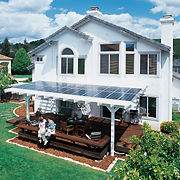
Will photovoltaics work on your house?
Although photovoltaics can produce electricity anywhere, certain factors will increase a PV system’s efficiency.
- A roof in North America should have a southern exposure and a slope of about 45°. Slopes between 15° and 60° are acceptable; panels also can be mounted on the ground or on outbuildings.
- Any shade cast on the panels significantly reduces the entire system’s output, so uninterrupted exposure is best, especially between 10 a.m. and 3 p.m.
- The geographic location and its weather determine the amount of solar potential. More efficient at lower temperatures, PV panels’ output is reduced by shorter days and lower sun angles; cloud cover reduces output by only 5% to 20%.
What will the future hold?
Over the last twenty years, the per-kWh price of photovoltaics has dropped from about $500 to nearly $5; think of what the next twenty years will bring. Some developments that are now in the trial stage include higher-efficiency solar cells that cost less to produce and translucent thin-film materials that generate current when applied to windows or skylights. Solar panels that have integral inverters in each unit are already in use in Australia and Europe. As the demand for PV grows, expect the prices to continue to drop and for increased support from the government as well.
Don’t forget the environmental savings
Next to global warming, acid rain, smog and pollution-related illnesses, the monetary savings of installing PV could be seen as secondary. Over the course of its life, a 2.4 kWh system such as the one mentioned above will decrease the burden on the environment by 70 tons of carbon dioxide, 810 lb. of sulfur oxide and 210 lb. of nitrogen oxide generated by conventional power plants.
Joe Provey is a freelance writer and a renewable-energy enthusiast living in Bridgeport, Connecticut. Photos courtesy of the National Renewable Energy Laboratories, except where noted; drawings: Mark Hannon









